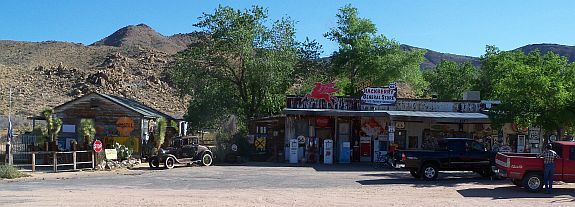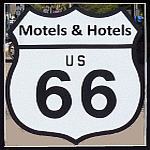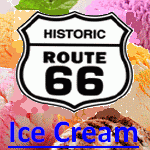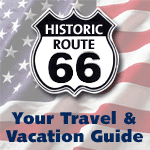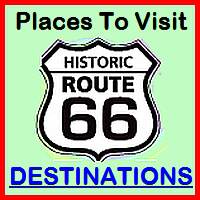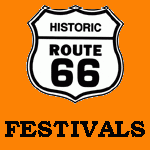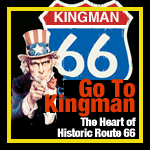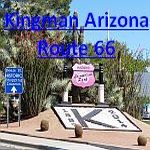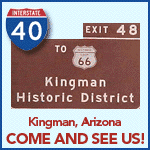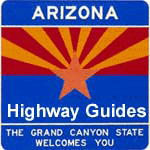 |
|
|
Route 66 has been called "the most famous highway in the world," and it remains the ultimate road trip. The highway runs from Chicago, Illinois, through Missouri, Kansas, Oklahoma, Texas, New Mexico, and Arizona before ending at Santa Monica, California, covering a total of 2,448 miles.
Before it was called Route 66, and long before it was even paved in 1926, this corridor was traversed by the National Old Trails Highway, one of the country’s first transcontinental highways. Route 66 has always been a path of the migrants who went west, especially during the Dust Bowl of the 1930s.
Route 66 invokes the ideas of freedom to move including migration West. The last great obstacle on Route 66 before reaching the California line was the road approaching Oatman, Arizona. The road was so steep that often cars had to back up it to get enough traction.
The oldest hotel on Route 66 is the Eagle Hotel in Wilmington, Illinois. Currently empty, the 1836 hotel that once serviced stagecoach travelers, has plans of restoration. |
| |
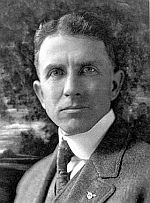 The Early 1900s - In the early 1900s, Cyrus Avery of Tulsa, Oklahoma, a realtor and owner of a coal company, began acquiring oil leases. With the need to reach the barren lands around him and the need for a roadway from the Midwest to the western lands connecting cities along the way, the road became a reality. The Early 1900s - In the early 1900s, Cyrus Avery of Tulsa, Oklahoma, a realtor and owner of a coal company, began acquiring oil leases. With the need to reach the barren lands around him and the need for a roadway from the Midwest to the western lands connecting cities along the way, the road became a reality.
"Main Street of USA" is a tagline invented by Cyrus Stevens Avery, the contractor who designed the road and considered Route 66's father. The rationale lies in the fact that Route 66 follows the main streets of most cities on its path. |
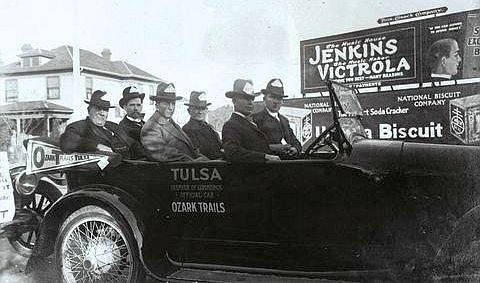 |
Cyrus Avery (third from left) supported the proposed Ozark Trail highway through Springfield, Missouri; Tulsa and Oklahoma City, Oklahoma; and Amarillo, Texas, in 1916.
Avery realized that an interstate system of highways would help his adopted city and state prosper. Ten years later, he established U.S. 66 along the same route.
He created the route while a member of the federal board appointed to create the Federal Highway System, then pushed for the establishment of the U.S. Highway 66 Association to pave and promote the highway. |
|
| |
| The 1920s - entrepreneurs Cyrus Avery of Tulsa, Oklahoma, and John Woodruff of Springfield, Missouri deserve most of the credit for promoting the idea of an interregional link between Chicago and Los Angeles. Their lobbying efforts for Route 66 paid off when it was established on November 11, 1926.
Officially, the numerical designation 66 was assigned to the Chicago-to-Los Angeles route in the summer of 1926, with road signs erected the following year. U.S. Route 66, also known as the Will Rogers Highway and as the Main Street of America or the Mother Road, was one of the original highways within the U.S. Highway System.
Route 66 was advertised by the U.S. Highway 66 Association as “The Main Street of America”. In the John Steinbeck novel The Grapes of Wrath, the highway is called “The Mother Road”, its prevailing title today.
Lou Mitchell’s Café has been providing breakfast for those beginning the long journey on Route 66 since the beginning. Opened in 1923 at 565 W. Jackson, breakfast is still served all day at Lou Mitchell’s in Chicago.
 Haggard family car (1926 Chevrolet) with trailer, during trip from Oklahoma to California. James F. and Flossie Haggard left Oklahoma in 1935 after a fire destroyed their barn and its contents. Haggard family car (1926 Chevrolet) with trailer, during trip from Oklahoma to California. James F. and Flossie Haggard left Oklahoma in 1935 after a fire destroyed their barn and its contents.
The Haggards and their children, Lillian and James Lowell, made their home near Bakersfield, and James found work with the Santa Fe Railway. Another son, Merle, was born in Bakersfield and began his singing career there. |
| |
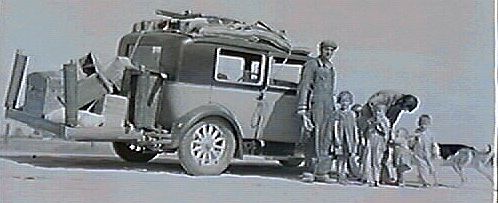 The 1930s - The Dust Bowl of the 1930s saw many farming families, mainly from Oklahoma, Arkansas, Kansas, and Texas, heading west for agricultural jobs in California. Thousands of hopefuls loaded up their battered old cars and trucks and motored west. The 1930s - The Dust Bowl of the 1930s saw many farming families, mainly from Oklahoma, Arkansas, Kansas, and Texas, heading west for agricultural jobs in California. Thousands of hopefuls loaded up their battered old cars and trucks and motored west.
Traffic grew on the highway as it became a popular truck route. By the 1930s the trucking industry was using Route 66. The truckers enjoyed the easier drive across the prairie lands and milder climates than the northern routes offered.
John Steinbeck conceived of "The Grapes of Wrath" on a late 1937 summer drive from Chicago west on Route 66, which he called the "long concrete path." |
| |
| The 1940s - the John Ford film, The Grapes of Wrath, which was released in 1940, twelve years before the association gave the road that name. Get your kicks on Route 66! At one time or another most of us have heard this 1946 song written by Bobby Troup and sung by the unforgettable Nat King Cole.
During World War II, westward migration continued as California had growing industries related to war-materials manufacturing. As a result, Route 66 (which was fully paved at this point) also became useful for moving military equipment around the country and to forts along its route.
The first McDonald’s restaurant was located in San Bernardino, California in 1945 on the Mother Road. The site is currently home to the McDonald's Route 66 Museum. |
| |
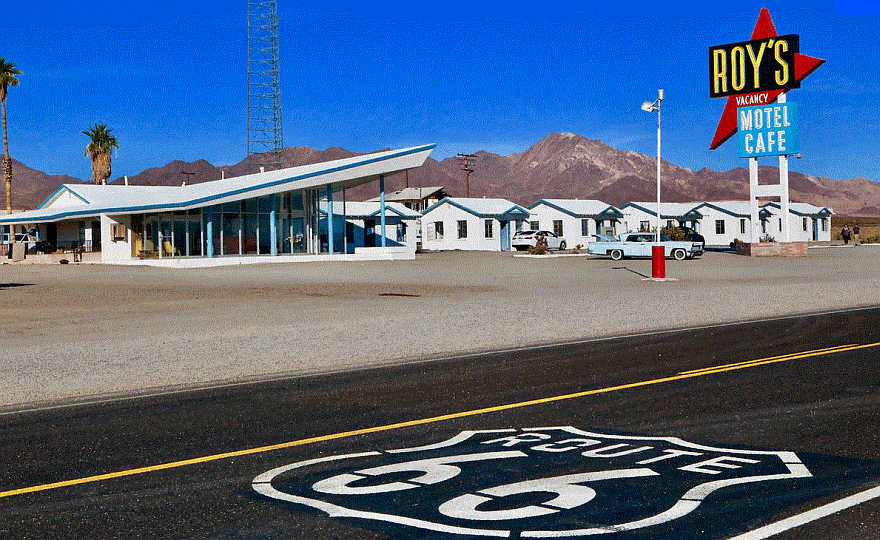 |
|
WELCOME TO AMBOY, CA
HOME OF THE FAMOUS ROY’S SIGN
IN THE MOJAVE DESERT ON HIGHWAY ROUTE 66.
Thе tоwn оf Ambоу аnd thе fаmоuѕ Rоу’ѕ Cаfé
аrе wеll knоwn tо trаvеlеrѕ оn оld Rоutе 66.
|
|
|
|
|
|
| |
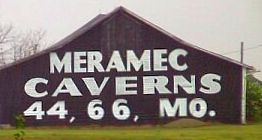 The 1950s -In the 1950s, Route 66 became the main highway for vacationers heading to Los Angeles. The road passes many popular stops. The sharp increase in tourism in turn gave rise to a burgeoning trade in all manner of roadside attractions, including teepee-shaped motels, frozen custard stands, Indian curio shops, and reptile farms. Meramec Caverns near St. Louis, began advertising on barns. Route 66 marked the birth of the fast-food industry. The 1950s -In the 1950s, Route 66 became the main highway for vacationers heading to Los Angeles. The road passes many popular stops. The sharp increase in tourism in turn gave rise to a burgeoning trade in all manner of roadside attractions, including teepee-shaped motels, frozen custard stands, Indian curio shops, and reptile farms. Meramec Caverns near St. Louis, began advertising on barns. Route 66 marked the birth of the fast-food industry.
Route 66 was unofficially named “The Will Rogers Highway” by the U.S. Highway 66 Association in 1952. This nickname is used primarily in Oklahoma, where the actor was born, as well as in surrounding states.
In 1956, the Federal Aid Highway Act was passed, which provided a financial umbrella to underwrite the national interstate and defense highway system. President Eisenhower enacted the Federal Aid Highway Act, inspired by the German autobahn he had seen during World War II. To keep up with growing traffic demands, pieces of Route 66 were slowly upgraded to, replaced by or became supplementary to new four-lane highways. |
| |
| The 1960s - As Interstates were constructed, sections of Route 66 not only saw the traffic drain to those Interstates, but often the name itself was moved to the faster means of travel. In some cases such as to the east of St. Louis this was done as soon as the Interstate was finished to the next exit.
From 1960 to 1964, the CBS television series Route 66 followed Tod Stiles (Martin Milner) and Buz Murdock (George Maharis) on their job-hunting travels across America in their Corvette convertible. The Corvette has become a Route 66 icon.
The 1965 Highway Beautification Act placed restrictions on signage which often denied merchants on the old road access to signage on the freeway, factors in the closure of many established Route 66 businesses as travellers could no longer easily find or reach them.
|
| |
| The 1970s - By 1970 nearly all of the original Route 66 was replaced by a modern four-lane highway and the popularity of the old road began to decline. By the 1970s, the route was largely replaced by five different interstates. Interstate 40, serving most of the Southwest, replaced the longest portion of the route.
Route 66's last stretch in Arizona was decommissioned when I-40 was completed in 1984. The following year, the entire route was decommissioned. The last Route 66 town to be bypassed by the interstate was Williams, Arizona. |
| |
| For nearly six decades, a two-lane road, running 2,448 miles, connected Chicago to Los Angeles. Route 66 was once considered an essential artery, its travelers a measure of America's pulse. Route 66 passes through a marvelous cross-section of American scenes. Route 66: ‘once you drive part of it – you’ll want to drive all of it!’
A famous national museum, nowhere near Route 66, has an exhibit that includes an actual piece of Route 66 pavement. Entitled "America On the Move," the piece of the Mother Road is at the Smithsonian's National Museum in Washington D.C. Route 66 is the most famous road built in America except it was actually made by connecting existing major highways together. And it was constantly mutating.
About 85% of Route 66 is still passable today. Over 2,000 of Route 66's original 2,448 connected miles are still approachable, if not always drivable. The only national park that Route 66 passes through is Petrified Forest National Park. In 1999, President Bill Clinton signed a National Route 66 Preservation Bill which provided for $10 million in matching fund grants for preserving and restoring the historic features along the route
From Chicago to Los Angeles, Route 66 spans three time zones. The Central Time Zone in Illinois, Missouri, Kansas, Oklahoma and Texas. The Mountain Time Zone in New Mexico and Arizona. The Pacific Time Zone in California.
Brown and white "historic" signs indicate Route 66's location in each of the eight states. Alternatively, its presence may be announced on the road surface itself.
"Sixty-Sixters" is a nickname for those who spend an average of two weeks to a month to travel Route 66 in all its length. Two weeks will allow for a few key visits but it is nice if you can spend a little more time on this trip of a lifetime. |
|
| |
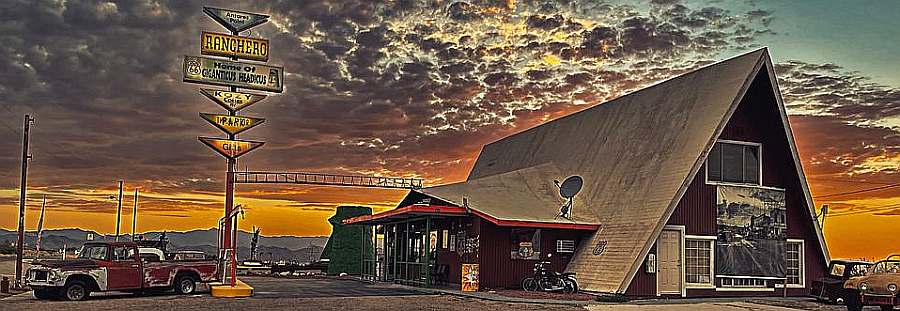 |
Antares Point Visitor Center and Gift Shop |
|
|
|
| |
|
|
|
|
| |
If you own a unique Route 66 domain name with content that you no longer want to maintain, please let us know.
We may be interested in taking it over so as to not have the world lose an interesting site. Internet Marketing Services |
|
|






 The 1950s -In the 1950s, Route 66 became the main highway for vacationers heading to Los Angeles. The road passes many popular stops. The sharp increase in tourism in turn gave rise to a burgeoning trade in all manner of roadside attractions, including teepee-shaped motels, frozen custard stands, Indian curio shops, and reptile farms. Meramec Caverns near St. Louis, began advertising on barns. Route 66 marked the birth of the fast-food industry.
The 1950s -In the 1950s, Route 66 became the main highway for vacationers heading to Los Angeles. The road passes many popular stops. The sharp increase in tourism in turn gave rise to a burgeoning trade in all manner of roadside attractions, including teepee-shaped motels, frozen custard stands, Indian curio shops, and reptile farms. Meramec Caverns near St. Louis, began advertising on barns. Route 66 marked the birth of the fast-food industry. 